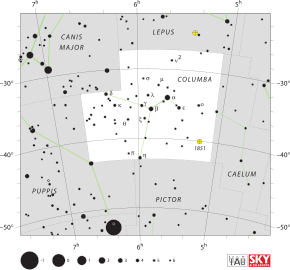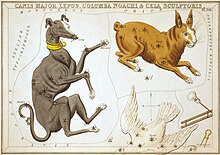

 06h00m00s, −35° 00′00″
06h00m00s, −35° 00′00″| Constellation | |

| |
| Abbreviation | Col |
|---|---|
| Genitive | Columbae |
| Pronunciation | /kəˈlʌmbə/, genitive /kəˈlʌmbiː/ |
| Symbolism | the dove |
| Right ascension | 05h03m 53.8665s–06h39m 36.9263s[1] |
| Declination | −27.0772038°–−43.1116486°[1] |
| Area | 270 sq. deg. (54th) |
| Main stars | 5 |
| Bayer/Flamsteed stars | 18 |
| Stars with planets | 1 |
| Stars brighter than 3.00m | 1 |
| Stars within 10.00 pc (32.62 ly) | 0 |
| Brightest star | α Col (Phact) (2.65m) |
| Messier objects | 0 |
| Meteor showers | 0 |
| Bordering constellations | Lepus Caelum Pictor Puppis Canis Major |
| Visible at latitudes between +45° and −90°. Best visible at 21:00 (9 p.m.) during the month of February. | |
Columba is a faint constellation designated in the late sixteenth century, remaining in official use, with its rigid limits set in the 20th century. Its name is Latin for dove. It takes up 1.31% of the southern celestial hemisphere and is just south of Canis Major and Lepus.


In the Society Islands, Alpha Columbae (Phact) was called Ana-iva.[10]
Columba is rather inconspicuous, the brightest star, Alpha Columbae, being only of magnitude 2.7. This, a blue-white star, has a pre-Bayer, traditional, Arabic name Phact (meaning ring dove) and is 268 light-years from Earth. The only other named star is Beta Columbae, which has the alike-status name Wazn. It is an orange-hued giant star of magnitude 3.1, 87 light-years away.[11]
The constellation contains the runaway star μ Columbae, which was probably expelled from the ι Orionis system.
Exoplanet NGTS-1b and its star NGTS-1 are in Columba.
Columba contains the solar antapex – the opposite to the net direction of the solar system[12] (noting the local spiral arm of the Milky Way itself is responsible for most of our change of position over time).[citation needed]
NGC 1851aglobular cluster in Columba appears at 7th magnitude in a far part of our galaxy as is 39,000 light-years away - it is resolvable south of at greatest latitude +40°N in medium-sized amateur telescopes (under good conditions).[11]